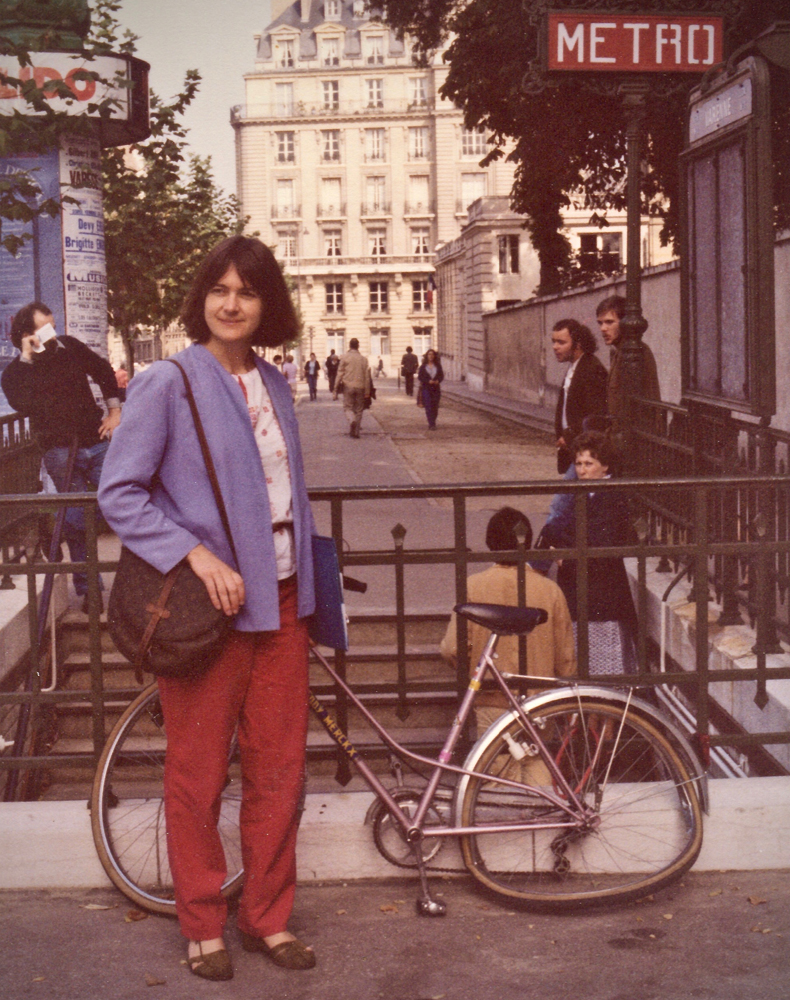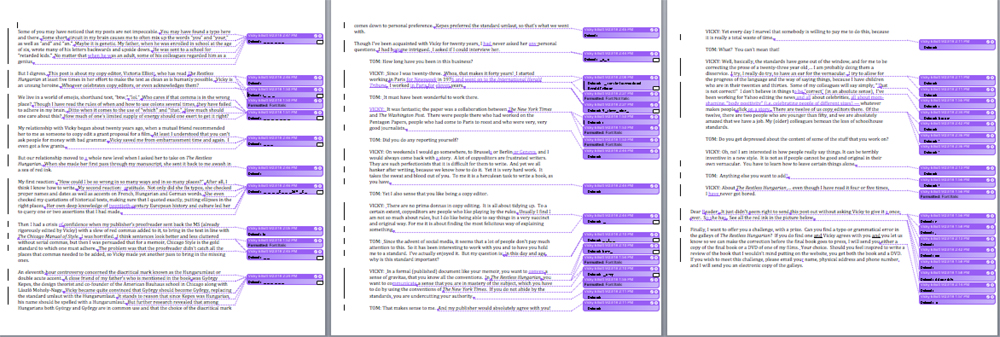Some of you may have noticed that my posts are not impeccable. You may have found a typo here and there. Some short-circuit in my brain causes me to often mix up the words “you” and “your,” as well as “and” and “an.” Maybe it is genetic. My father, when he was enrolled in school at the age of six, wrote many of his letters backwards and upside down. He was sent to a school for “retarded kids.” No matter that when he was an adult, some of his colleagues regarded him as a genius.
But I digress. This post is about my copy editor, Victoria Elliott, who has read The Restless Hungarian at least five times in her effort to make the text as clean as is humanly possible. Vicky is an unsung heroine. Whoever celebrates copy editors, or even acknowledges them?
We live in a world of emojis, shorthand text, “btw,” “lol.” Who cares if that comma is in the wrong place? Though I have read the rules of when and how to use colons several times, they have failed to adhere in my brain. Ditto when it comes to the use of “which” and “that.” How much should one care about this? How much of one’s limited supply of energy should one exert to get it right?
My relationship with Vicky began about twenty years ago, when a mutual friend recommended her to me as someone to copy edit a grant proposal for a film. At least I understood that you can’t ask people for money with bad grammar. Vicky saved me from embarrassment time and again. I even got a few grants.

But our relationship moved to a whole new level when I asked her to take on The Restless Hungarian. When she made her first pass through my manuscript, she sent it back to me awash in a sea of red ink.
My first reaction: “How could I be so wrong in so many ways and in so many places?” After all, I think I know how to write. My second reaction: gratitude. Not only did she fix typos, she checked proper names and dates as well as accents on French, Hungarian and German words. She even checked my quotations of historical texts, making sure that I quoted exactly, putting ellipses in the right places. Her own deep knowledge of twentieth-century European history and culture led her to query one or two assertions that I had made.
Then I had a crisis of confidence when my publisher’s proofreader sent back the manuscript (already rigorously edited by Vicky) with a slew of red commas added to it, to bring in the text in line with The Chicago Manual of Style. I was horrified.
I think sentences look better and less cluttered without serial commas, but then I was persuaded that for a memoir, Chicago Style is the gold standard to which one must adhere. The problem was that the proofreader didn’t catch all the places that commas needed to be added, so Vicky made yet another pass to bring in the missing ones.
An eleventh-hour controversy concerned the diacritical mark known as the Hungarumlaut or double acute accent. A close friend of my father’s who is mentioned in the book was György Kepes, the design theorist and co-founder of the American Bauhaus school in Chicago along with László Moholy-Nagy. Vicky became quite convinced that György should become Győrgy, replacing the standard umlaut with the Hungarumlaut. It stands to reason that since Kepes was Hungarian, his name should be spelled with a Hungarumlaut. But further research revealed that among Hungarians both György and Győrgy are in common use and that the choice of the diacritical mark comes down to personal preference. Kepes preferred the standard umlaut, so that’s what we went with.
Though I’ve been acquainted with Vicky for twenty years, I had never asked her any personal questions. I had become intrigued. I asked if I could interview her.
TOM: How long have you been in this business?
VICKY: Since I was twenty-three. Whoa, that makes it forty years! I started working in Paris for Newsweek in 1976 and went on to the International Herald Tribune. I worked in Paris for eleven years.
TOM: It must have been wonderful to work there.
VICKY: It was fantastic; the paper was a collaboration between The New York Times and The Washington Post. There were people there who had worked on the Pentagon Papers, people who had come to Paris to roost and who were very, very good journalists.

TOM: Did you do any reporting yourself?
VICKY: On weekends I would go somewhere, to Brussels or Berlin or Geneva, and I would always come back with a story. A lot of copyeditors are frustrated writers. They are such perfectionists that it is difficult for them to write. And yet we all hanker after writing, because we know how to do it. Yet it is very hard work. It takes the sweat and blood out of you. To me it is a herculean task to write a book, as you have.
TOM: Yet I also sense that you like being a copy editor.
VICKY: There are no prima donnas in copy editing. It is all about tidying up. To a certain extent, copyeditors are people who like playing by the rules. Usually I find I am not so much about rules, but I do like being able to say things in a very succinct and original way. For me it is about finding the most felicitous way of explaining something.
TOM: Since the advent of social media, it seems that a lot of people don’t pay much attention to this. So it has been interesting to work with you and to have you hold me to a standard. I’ve actually enjoyed it. But my question is: In this day and age why is this standard important?
VICKY: In a formal (published) document like your memoir, you want to convey a sense of gravitas, that you know all the conventions. In The Restless Hungarian, you want to communicate a sense that you are in mastery of the subject, which you have to do by using the conventions of The New York Times. If you do not abide by the standards, you are undercutting your authority.
TOM: That makes sense to me. And my publisher would absolutely agree with you!
VICKY: Yet every day I marvel that somebody is willing to pay me to do this, because it is really a total waste of time.
TOM: What? You can’t mean that!
VICKY: Well, basically, the standards have gone out of the window, and for me to be correcting the prose of a twenty-three year old … I am probably doing them a disservice. I try, I really do try, to have an ear for the vernacular. I try to allow for the progress of the language and the way of saying things, because I have children who are in their twenties and thirties. Some of my colleagues will say simply: “That is not correct!” I don’t believe in things to be “correct” (in an absolute sense). I’ve been working for Yahoo editing the news and all about celebrities, all about mom-shaming, “body positivity” (i.e. celebrating people of different sizes) — whatever makes people click on a story. There are twelve of us copy editors there. Of the twelve, there are two people who are younger than fifty, and we are absolutely amazed that we have a job. My (older) colleagues bemoan the loss of schoolhouse standards.
TOM: Do you get depressed about the content of some of the stuff that you work on?
VICKY: Oh, no! I am interested in how people really say things. It can be terribly inventive in a new style. It is not as if people cannot be good and original in their own vernacular. You have to learn how to leave certain things alone.
TOM: Anything else you want to add?
VICKY: About The Restless Hungarian … even though I have read it four or five times, I have never got bored.
Dear Reader: It just didn’t seem right to send this post out without asking Vicky to give it a once-over. So she has. See all the purple ink in the picture below.
A CHALLENGE TO READERS
Finally, I want to offer you a challenge, with a prize. Can you find a typo or grammatical error in the galleys of The Restless Hungarian? If you do find one and Vicky agrees with you and you let us know so we can make the correction before the final book goes to press, I will send you either a copy of the final book or a DVD of one of my films. Your choice. Should you feel inspired to write a review of the book that I wouldn’t mind putting on the website, you get both the book and a DVD. If you wish to meet this challenge, please email your name, physical address and phone number, and I will send you an electronic copy of the galleys. I will respond to the first ten people who email me.

Kathy
October 10, 2018 at 1:08 pmAnother wonderful blog!!!! I do enjoy reading your writing and anxiously await “The Restless Hungarian”.
Kathy
P.S. I am not one to ever be able to proofread anything. Ceecee is my editor!!!
Cynthia Eaton
October 3, 2018 at 2:46 pmHi Tom,
Just read the interview and challenge. Am I too late?
Cynthia Eaton
Tom Weidlinger
October 11, 2018 at 11:49 pmNo. Advance reader copies will be available in early November.
mimi moungovan
September 29, 2018 at 9:13 pmI have never GOT bored
???
Tom Weidlinger
October 11, 2018 at 11:48 pmMimi: Well, you see what I mean!